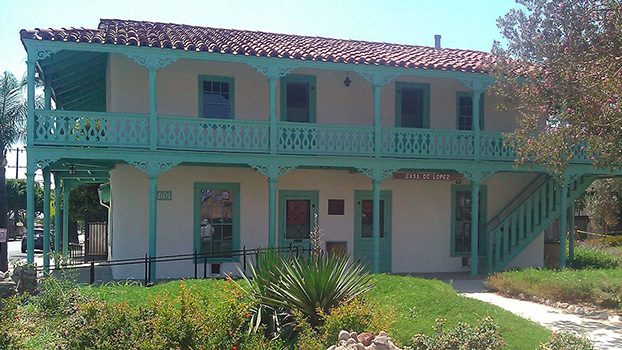
Lopez Adobe stands strong.
HRG played a key role in the rehabilitation of one of Southern California’s rare 19th century treasures, the Lopez Adobe in the City of San Fernando. HRG tasks included analysis and review of rehabilitation work, design, and execution to meet historic preservation standards. Since acquiring the early residential landmark in 1970, the City and supportive citizens have maintained the site, home, and collection as a public museum. The recently completed project improved seismic safety, repaired deteriorated features, improved accessibility, and provided for landscaping that is more compatible with the site while accommodating public outdoor uses. This work culminated in a 2013 Preservation Award from the Los Angeles Conservancy.
Side: Lopez Adobe, San Fernando. Photograph Courtesy of the City of San Fernando.
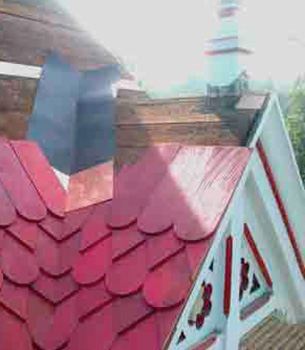
Lucky Baldwin landmarks are re-roofed.
Elias Jackson (“Lucky”) Baldwin’s 1885 “Queen Anne” Cottage and Coach Barn are ornate examples of Victorian extravagance. Alternating slats of cedar and redwood interior paneling and original iron grillwork contribute to the feeling of opulence. The Coach Barn housed Baldwin’s collection of private carriages. The Baldwin Estate is a popular film location, appearing in popular movies and TV series such as Tarzan, Fantasy Island, and Meet the Fockers.
Historic Resources Group assisted a large team, including Mitchell Bishop, Curator of Historic Collections at the Los Angeles County Arboretum and Botanic Garden; LA County Parks and Recreation staff; LA County contractors; historian Sandy Snider; and historic architect Bill Ellinger, in protecting the Cottage and Coach Barn through a sound and authentic replacement of deteriorating wood roof shingles. Although the original roof materials were no longer extant, the Los Angeles County Arboretum’s records and other archival sources were used to identify the original materials and find appropriate replacements. Custom shingle widths were specified, fire-retardant stain colors were adjusted, shingle courses were counted, complex imbrication patterns were reproduced, and new sheet metal and copper flashings were installed.
Above: Coach Barn Roof, Los Angeles County Arboretum.
Side: Coach Barn, Lucky Baldwin’s Ranch, c. 1880s. Historic Photograph Courtesy of Braun Research Library, Autry National Center.
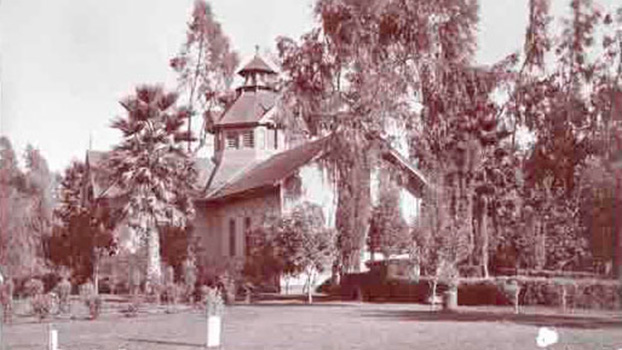
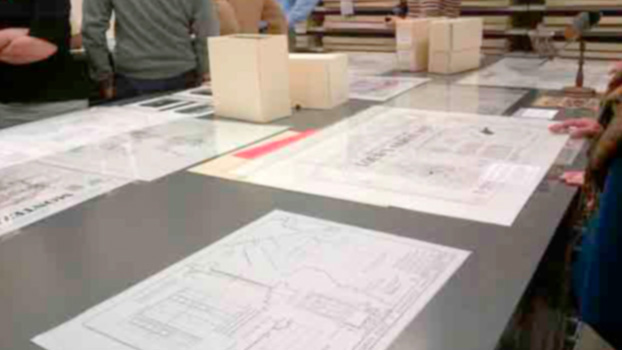
HRG provides national leadership.
HRG’s Principal Architect, Peyton Hall, FAIA, currently serves as one of the five national Advisors to the American Institute of Architects Historic Resources Committee. In March, he visited the Historic American Building Survey (HABS) collection at the Library of Congress in Washington, D.C., accompanying the student winners of the 2013 Charles E. Peterson Prize for Measured Drawings given by the National Park Service, the American Institute of Architects, and Athenaeum of Philadelphia. The HABS program is jointly sponsored by the National Park Service, the Library of Congress, and the American Institute of Architects.
Side: Library of Congress HABS Collection, Washington, D.C.
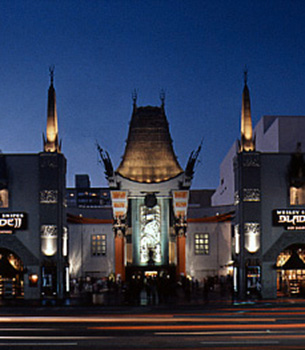
New life for old buildings
In 2001 the Chinese Theatre, perhaps Los Angeles’s most visited tourist attraction, emerged from decades of obscurity behind commercial signage and awnings. HRG assisted Mann Theatres and Behr Browers Architects in that work. Sadly for historic theatres, single screen houses are failing to draw audiences, compared to cineplexes, and large chain exhibitors compete fiercely for the most popular new blockbuster movies. Currently, new owners Elie Samaha and Don Kushner are seeking a viable economic future for the “Chinese” by installing a new digital IMAX projector and projection screen. The leading edge technology is exclusive to very few venues, and will therefore draw the attention of studios, directors, and moviegoers. The only major alteration required is more steeply raked seating; this is a reversible change to the auditorium floor—a floor that has been previously altered. Later this year moviegoers will experience the best in screening technology, and the symbol of Sid Grauman’s showmanship will live on.
Above: Chinese Theatre, Los Angeles.
Side: 28th Street YMCA, Los Angeles. Courtesy of Eric Staudenmaier.
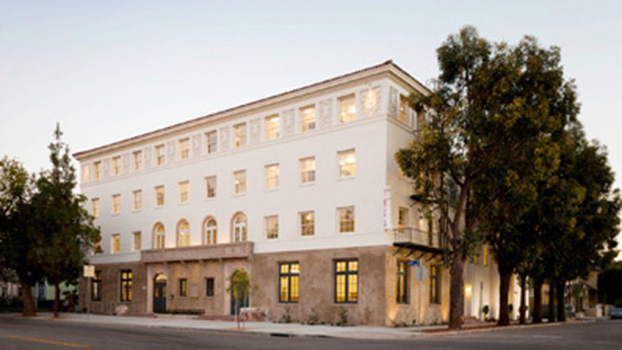
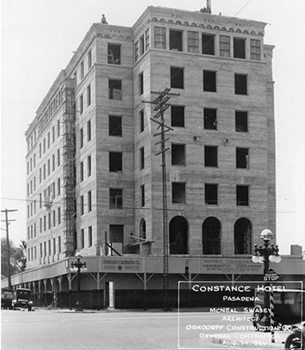
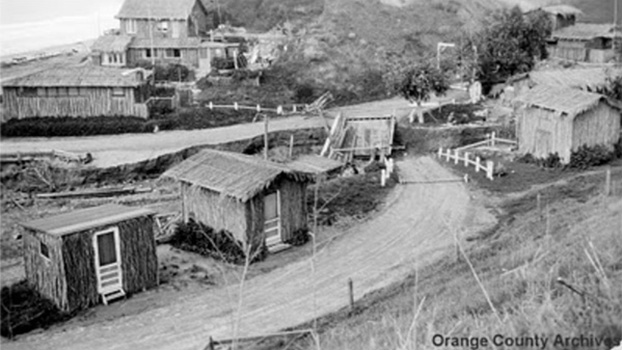
Sharing our expertise
HRG frequently works with staff and commissioners on behalf of public and private owners to assure that applicants get good assistance, planning staff sees good projects, and commissioners understand the issues and outcomes. HRG sponsored and Peyton Hall participated in the National Alliance of Preservation Commissions 2012 Forum in Norfolk, Virginia. As a follow up, Peyton was invited to write a substantial article for the September-October 2012 issue of The Alliance Review, titled “A Seismic Shift in Historic Urban Development: Lessons Learned from the Crash of 2008.” The article provides a Western, private sector perspective on development to a national audience consisting mostly of citizen commissioners and public planners. Case studies included the Rose Bowl and the Hotel Constance.
HRG worked with the Los Angeles Conservancy on the first phase of “Curating the City: Modern Architecture in L.A., 1940-1990,” which is part of the Getty Research Institute’s Pacific Standard Time Presents: Modern Architecture in L.A. HRG facilitated meetings of experts in the field of modern architecture, architectural history, and historic preservation to help the Los Angeles Conservancy define how best to tell the story of modern architecture in Greater Los Angeles, why it matters, and why it merits preservation. As part of these lively and informative discussions, a list of over 1,000 significant modern buildings and sites was compiled, which will be used by the Conservancy to create an online searchable database and map.
Historic Resources Group is a 2013 Annual Sponsor of theCalifornia Preservation Foundation. Sponsorships are critical to the California Preservation Foundation’s efforts to fulfill its mission to ensure the protection of California’s diverse cultural heritage and historic places through education, advocacy, and leadership. Over time, HRG has contributed three board members and two Presidents to CPF, demonstrating a long history of support.
For CPF’s annual conference in Orange County on May 1-3, 2013, Peyton Hall sits on the Program Committee, planning study tours of Eichler homes, the Richard Neutra and Philip Johnson buildings at the “Crystal Cathedral,” and Santa Ana, the County’s historic urban center. Attendees will also be able to visit two extraordinary hidden gems: Arden, the Helena Modjeska Historic House and Gardens, and Crystal Cove State Beach, thanks to Sue McIntire, Historic Resource Manager of the Orange County Historical Parks.
Above: Historic image of the Hotel Constance, Pasadena. Courtesy of the collection of the Pasadena Museum of History.
Side: Crystal Cove, Laguna Beach. Courtesy of the Orange County Archives.